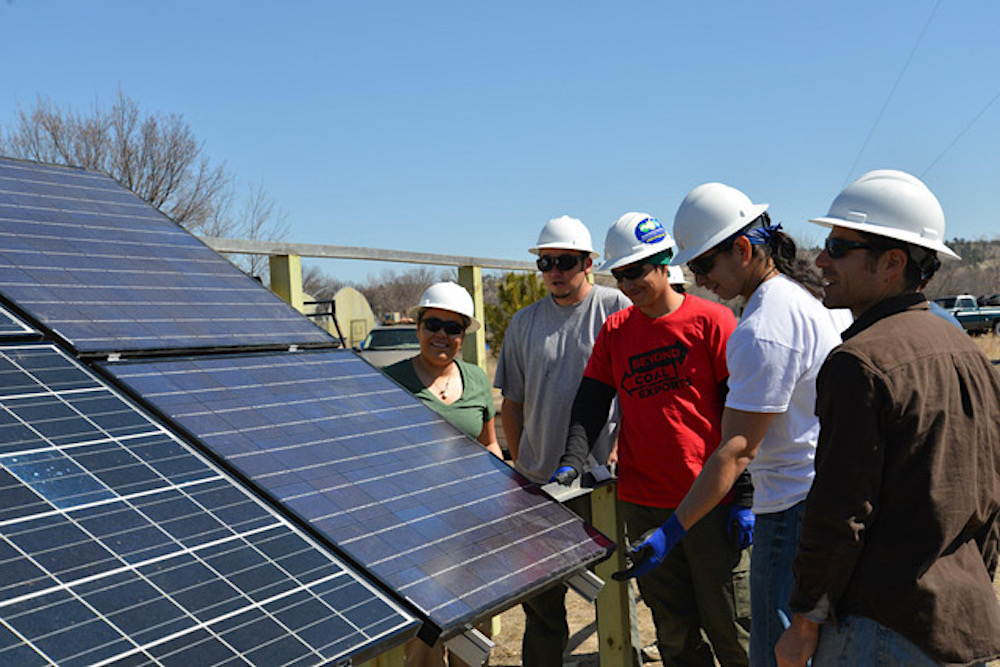
- Details
- By Chez Oxendine
- Energy | Environment
A three-year, nearly $1.7 million Department of Energy grant will help a Native-led renewable energy nonprofit weatherize 30 homes across three reservations.
The Pine Ridge, S.D.-based Red Cloud Renewables plans to retrofit these homes with improved insulation, doors and windows alongside solar panels and a solar furnace, which could save the residents up to 50 percent of their utility bills, said Managing Director John Red Cloud.
“We are providing deep energy retrofits to the Pine Ridge Reservation, the Rosebud Sioux Reservation and the Standing Rock Reservation,” Red Cloud told Tribal Business News. “We’re hoping to be a flagship for this process and set the standard for it going forward.”
Red Cloud Renewables’ proposed project, titled “Native to Native Energy Sovereignty,” received the grant award as part of the DoE’s Weatherization Assistance Program. The project is one of 21 “enhancement and innovation” projects awarded a total of $36.5 million, according to the DOE.
Weatherization assistance aims to reduce homeowners’ costs by assessing structural weaknesses that cause homes to use more energy to stay cool or warm, and then provides insulation, caulking or weather strips to reduce those inefficiencies.
U.S Secretary of Energy Jennifer Granholm described weatherization as a process that could save families significant amounts on their utility bills.
“Weatherization is a great way to save hundreds of dollars on energy bills, but unfortunately aging electrical systems and structural complications keep homes in disrepair locked out of this money saving benefit,” Granholm said. “Today’s funding from DOE doubles down on the Bipartisan Infrastructure Law’s $3.5 billion investment in weatherization assistance by getting homes weatherization ready, helping thousands of Americans save money on their utility bills, and developing the next generation of a clean energy workforce.”
For Red Cloud Renewables, that means funding for “deep energy retrofits,” which combine a full assessment of each home with potential upgrades and weatherization efforts to lower homeowners’ costs.
“We’re trying to create an envelope around the home where it’s nice and tidy, where heat consumption and appliance or energy use are at their most optimal,” Red Cloud said. “We’re looking at a systems-wide approach: the HVAC, the air quality, where is heat escaping, where is heat being retained, where did contractors maybe kind of skimp. We need to look under rugs, in the attic.”
From there, Red Cloud Renewables will help weatherize the residence, and then fit it with a solar furnace, photovoltaic panels and vertical solar collectors to provide homeowners with their own energy, offsetting more of their costs.
Homeowners should see their utility bills cut in half — important savings for many Native Amercians who already pay exorbitant utility costs, Red Cloud said.
“Many homes burn wood or propane, which is incredibly expensive and oftentimes outpaces a family’s income,” Red Cloud said. “The need is great and the resources are few, so we’re doing what we can to help.”
Moreover, weatherization and solar retrofits can help tribes take another small step toward energy sovereignty by providing homeowners with some of their own energy.
Helping tribal members take control of their resources and building energy solutions in line with their duties to the environment form an important part of the mission for Red Cloud Renewables.
“We take that sovereignty concept seriously to a greater extent than the average American,” Red Cloud said. “The reservations we’re working with really believe in that. It means economic sovereignty, energy sovereignty, and we believe our ability to balance with nature can provide that to us.”
By taking back part of the control over their energy, Native Americans can pull away from companies that often don’t have the same end goals as the reservations they do business with, Red Cloud added.
“A lot of it is about our people,” he said. “We’re trying to help our people and we’re not worried about the shareholders A, B and C. We don’t want to be beholden to public utility companies or a co-op.”
While the nonprofit has compiled a short list of potential homes for retrofitting and renewable upgrades by working with reservations to identify needs and suitability, it has more work to do beyond the initial grant.
Red Cloud hopes that the initial results from the first retrofitted homes will make the case for weatherization and solar energy and garner more funding for future projects.
“We’re positioned as an organization to really take this and take the lead on these kinds of projects. We think it’s time to try it and see where it goes,” Red Cloud said. “Now it’s our time to be a solar champion for our people. That’s what we’re trying to do.”
